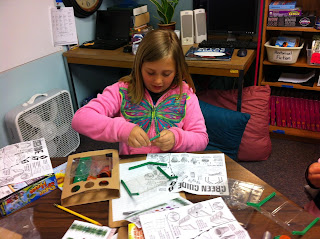After 7 days the plants were doing very well and the kids were excitedly keeping up with their watering regimes. For most of the students, the amount they watered was 5 ml each day per plant. We were finally able to talk about what they had learned from growing, tending, and trying to keep accuarate records. Learning to do the work and keep track of all the things you are doing takes real concentration and effort. When we went over their charts, some found incomplete information, or thought they wrote more than they did. It was a good lesson about how to set up routines when taking accurate science data.
During the discussion we found out that the mung beans had the best results. Everyone had 100% sprouting. We did the math calculations for all three seed types. 19/22 students had sunflowers sprout. And, only 2/22 had the sensitive seeds sprout. We talked about the reasons and thought about the particular habitats those seeds would usually be found. We notices the size difference and thought about adaptation more.

During the discussion we found out that the mung beans had the best results. Everyone had 100% sprouting. We did the math calculations for all three seed types. 19/22 students had sunflowers sprout. And, only 2/22 had the sensitive seeds sprout. We talked about the reasons and thought about the particular habitats those seeds would usually be found. We notices the size difference and thought about adaptation more.

 |
| Removing the little plants was a very careful process. |
Working with the seeds allowed us to think about what has been the theme of science--adaptation. Looking at form and function at animals and plants proved to be interesting and good for world connections. The kids had lots of things to say about what they noticed and figured out.
















.JPG)
.JPG)
.JPG)
.JPG)
.JPG)
.JPG)
.JPG)
.JPG)
.JPG)
.JPG)
.JPG)
.JPG)
.JPG)
.JPG)
.JPG)
.JPG)
.JPG)
.JPG)
.JPG)
.JPG)
.JPG)
.JPG)
.JPG)
.JPG)
.JPG)
.JPG)
.JPG)
.JPG)
.JPG)
.JPG)